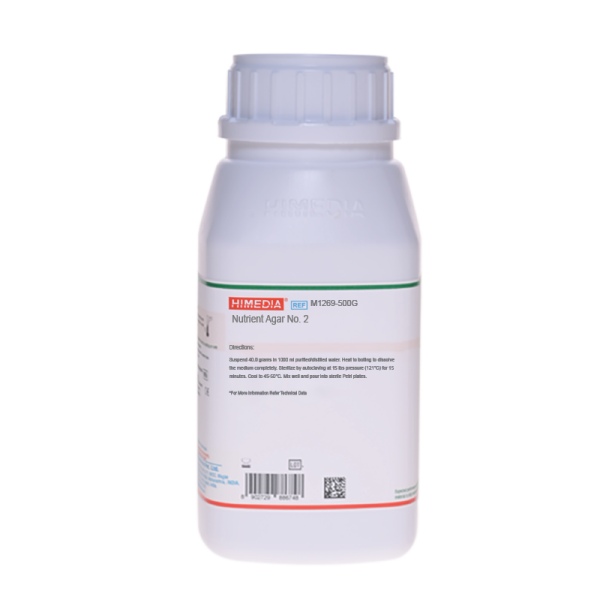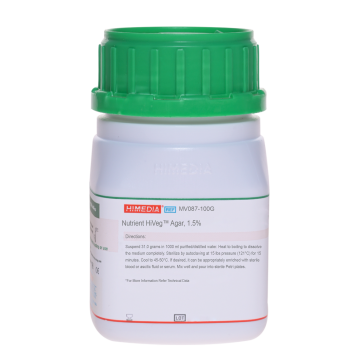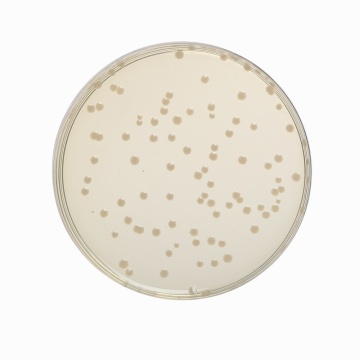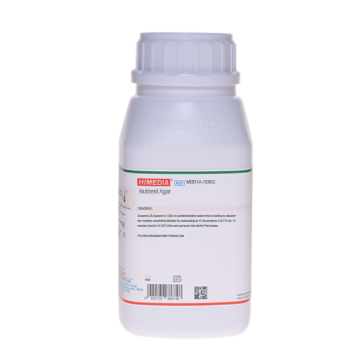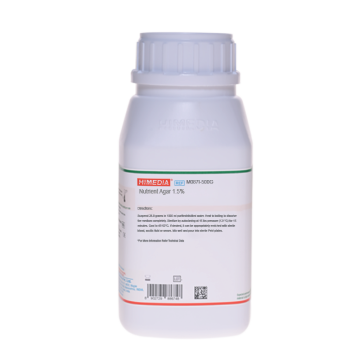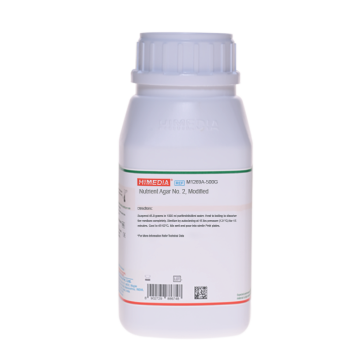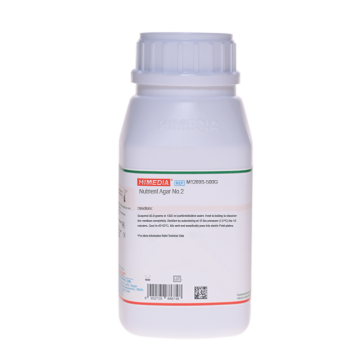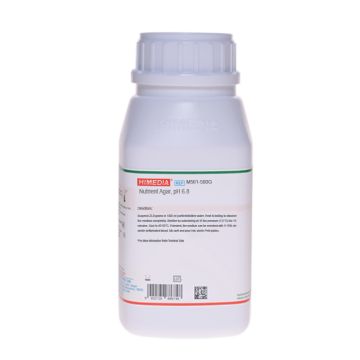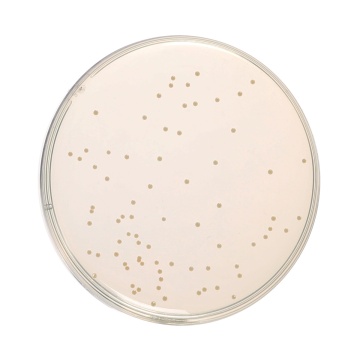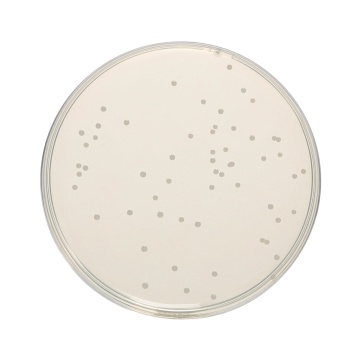 Your enquiry has been submitted
Your enquiry has been submitted
Nutrient Agar No.2
Intended Use:
Used as a general purpose culture medium.
Composition
| Ingredients | g/L |
|---|---|
| Peptone | 10.000 |
| HM peptone B # | 10.000 |
| Sodium chloride | 5.000 |
| Agar | 15.000 |
Final pH (at 25°C): 7.2±0.2
**Formula adjusted, standardized to suit performance parameters
# - Equivalent to Beef extract
Directions
Suspend 40.0 grams in 1000 ml purified/distilled water. Heat to boiling to dissolve the medium completely. Sterilize by autoclaving at 15 lbs pressure (121°C) for 15 minutes. Cool to 45-50°C. Mix well and pour into sterile Petri plates.
Principle And Interpretation
Nutrient Media are general purpose media used for the examination of water and dairy products according to Standard Methods for the Examination of Water and Waste water (1) and Dairy Products (2). Nutrient Agar No. 2 can be used for the microbiological analysis of water as per Czech Standards. It can also be used for sterility testing of aerobes and also for maintenance of subcultures (3). As a general purpose can be used for clinical samples also.
HM peptone B and peptone provide the necessary nitrogen compounds, carbon, long chain amino acids, vitamins and also some trace ingredients to the bacteria. Sodium chloride maintains osmotic equilibrium of the medium.
Type of specimen
Clinical samples- faeces, urine, etc.; Food and dairy samples; Water samples
Specimen Collection and Handling
For clinical samples follow appropriate techniques for handling specimens as per established guidelines (4,5).
For food and dairy samples, follow appropriate techniques for sample collection and processing as per guidelines (2,6,7).
For water samples, follow appropriate techniques for sample collection, processing as per guidelines and local standards (1).
After use, contaminated materials must be sterilized by autoclaving before discarding.
Warning and Precautions
In Vitro diagnostic use. For professional use only. Read the label before opening the container. Wear protective gloves/protective clothing/eye protection/face protection. Follow good microbiological lab practices while handling specimens and culture. Standard precautions as per established guidelines should be followed while handling clinical specimens. Safety guidelines may be referred in individual safety data sheets.
Limitations
- Individual organisms differ in their growth requirement and may show variable growth patterns on the medium.
- Each lot of the medium has been tested for the organisms specified on the COA. It is recommended to users to validate the medium for any specific microorganism other than mentioned in the COA based on the user's unique requirement.
- Further serological and biochemical testing is required for complete identification.
Performance and Evaluation
Performance of the medium is expected when used as per the direction on the label within the expiry period when stored at recommended temperature.
Quality Control
Appearance: Cream to yellow homogeneous free flowing powder
Gelling: Firm, comparable with 1.5% Agar gel
Colour and Clarity of prepared medium: Light yellow to amber coloured clear to slightly opalescent gel forms in Petri plates
Reaction: Reaction of 4.0% w/v aqueous solution at 25°C. pH: 7.2±0.2
pH: 7.00-7.40
Cultural Response
Cultural characteristics observed after an incubation at 35-37°C for 18-24 hours
| Organism | Inoculum (CFU) | Growth | Recovery |
|---|---|---|---|
| Escherichia coli ATCC 25922 (00013*) | 50-100 | luxuriant | >=70% |
| # Klebsiella aerogenes ATCC 13048 (00175*) | 50-100 | luxuriant | >=70% |
| Klebsiella pneumoniae ATCC 13883 (00097*) | 50-100 | luxuriant | >=70% |
| Salmonella Typhimurium ATCC 14028 (00031*) | 50-100 | luxuriant | >=70% |
Key: (*) Corresponding WDCM numbers (#) Formerly known as Enterobacter aerogenes.
Storage and Shelf Life
Store between 10-30°C in a tightly closed container and the prepared medium at 20-30°C. Use before expiry date on the label. On opening, product should be properly stored dry, after tightly capping the bottle in order to prevent lump formation due to the hygroscopic nature of the product. Improper storage of the product may lead to lump formation. Store in dry ventilated area protected from extremes of temperature and sources of ignition. Seal the container tightly after use. Product performance is best if used within stated expiry period.
Disposal
User must ensure safe disposal by autoclaving and/or incineration of used or unusable preparations of this product. Follow established laboratory procedures in disposing of infectious materials and material that comes into contact with clinical sample must be decontaminated and disposed of in accordance with current laboratory techniques (4,5).
Reference
- Lipps WC, Braun-Howland EB, Baxter TE, eds. Standard methods for the Examination of Water and Wastewater, 24th ed. Washington DC:APHA Press; 2023.
- American Public Health Association, Standard Methods for the Examination of Dairy Products, 1978, 14th Ed., Washington D.C.
- MacFaddin J. F., 2000, Biochemical Tests for Identification of Medical Bacteria, 3rd Ed., Lippincott, Williams and Wilkins, Baltimore.
- Isenberg, H.D. Clinical Microbiology Procedures Handbook 2nd Edition.
- Jorgensen, J.H., Pfaller, M.A., Carroll, K.C., Funke, G., Landry, M.L., Richter, S.S and Warnock., D.W. (2015) Manual of Clinical Microbiology, 11th Edition. Vol. 1.
- Salfinger Y., and Tortorello M.L., 2015, Compendium of Methods for the Microbiological Examination of Foods, 5th Ed., American Public Health Association, Washington, D.C.
- Wehr H. M. and Frank J. H., 2004, Standard Methods for the Microbiological Examination of Dairy Products, 17th Ed., APHA Inc., Washington, D.C.
| Product Name | Nutrient Agar No.2 |
|---|---|
| SKU | M1269 |
| Product Type | Regular |
| Physical Form | Powder |
| Origin | Animal |
| Packaging type | HDPE |
| References | 1. Clesceri L. S, Greenberg A. E. and Eaton A. D., (Eds.), 1998, Standard Methods for the Examination of Water andWastewater, 20th Ed., APHA, Washington, D.C. |
| Customized Product Available | No |



